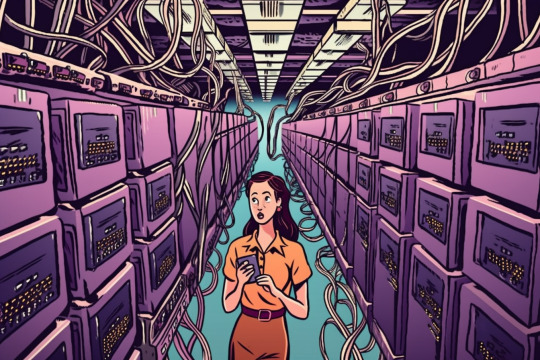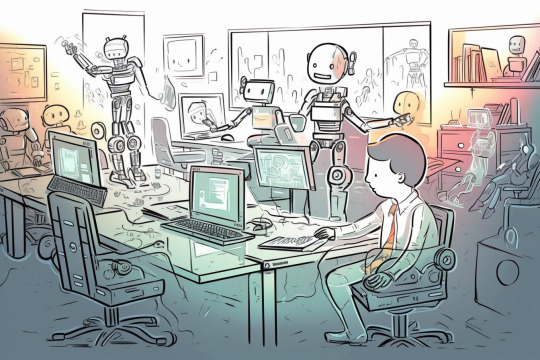#GPU Computing Online Help | GPU Computing Homework Help | GPU Computing Applications | GPU Computing High School Assignment Help | GPU Compu
Explore tagged Tumblr posts
Text
The emerging AI revolution

The second chatbot explosion
The advent of AI chatbots has already made a significant impact on our digital landscape, with platforms like ChatGPT demonstrating the potential for super-human intelligence in a conversational AI. ChatGPT is already passing university-level tests, despite not even being trained to be especially clever. However, the real game-changer in this space to me seems to be the emergence of Alpaca, an tiny branch of a Facebook model with one very impactful quirk: Unlike ChatGPT, which relies on millions of dollars worth of server-grade GPUs, Alpaca can run on any computer as small as a Raspberry Pi, significantly broadening its reach and adoption.
As a result of this increased accessibility, we're likely to witness a massive explosion in the number of chatbots that are indistinguishable from human actors. Chatbots can reason, they can be emotional, they can simulate a personality, all to a level of sophistication that makes it completely opaque that there is no human behind the keyboard. This sudden widening access to chatbots is, on its surface, a huge power boost: now you only need a handful of computers and accounts to completely dominate an online discussion with your opinion. However, because your opponents have the same capabilities, I don't expect easy domination and rather a drastic increase in overall online activity. Within a few months, this development might escalate to the point that the majority of apparent users we encounter online, could be AI chatbots rather than real people. Superficial human quirks like sleeping times or lunch breaks are trivial to simulate.
This explosion of chatbots brings to light an important issue: these AI agents are not neutral. They will be overwhelmingly controlled by well-funded interests, such as state actors, corporations, or large political tribes, manipulating the narrative en masse and creating a false appearance of consensus. Users might not appreciate this shift in tone, or the constant series of realizations that the apparent idological opponent turns out to be an AI that never change their mind. A complete erosion of trust in anonymous online communication seems to be the obvious next phase.
To counteract this, users might resort to chatbot bans, although it's challenging to identify and block chatbots that pass the Turing test. Another potential remedy could be shifting to voice chat. However, if AI eventually becomes proficient in voice communication as well, the whole concept of anonymous human interaction could break down. I expect this development to drive people either into small, tight-knit groups of trusted individuals, or away from the internet altogether.
In this scenario, even after the exodus of human users, the sheer number of chatbots could keep overall activity in anonymous spaces from declining. This leads to the "dead internet" scenario: billions of bots screaming at each other, site metrics higher than ever, but no more human in sight. Only the steadily dropping ad revenue will be a hint of the underlying shift. Bots don't buy things.

AI disrupting white-collar labor
However, chatbots are just the beginning. Language AIs are already better than us at handling mundane, everyday tasks like explaining a kid's homework step-by-step, writing job applications, or writing eulogies. The whole range of white collar workers will soon find that AIs can be a huge help when taking over the tedious aspects of their work, such as writing renovation plans, annual job evaluations, or formal requirement documents. As the use of AI becomes more widespread, workers who can effectively harness its capabilities will likely thrive, while those who struggle to adapt will be left behind.
And this is a quite short-term development: Today's AI assistance tools, like Microsoft's Copilot, are already capable of automating a wide range of tasks, from drafting emails and summarizing online meetings to proposing agenda points - tasks that employ hundreds of thousands of executive assistants today. The AI help can reduce the time and energy spent on repetitive tasks, allowing office workers to focus on more critical aspects of their jobs - but they also can make them obsolete.
This development, like all industrial revolutions before it, raises concerns about the potential for AI to exacerbate existing inequalities. If we're not careful, we're about to tread familiar ground: automation starts displacing workers, but the machines stay in the hands of the ownership class, while workers compete in a race to the bottom.
Historically, we can find examples of how automation has displaced workers during times of rapid technological progress. The Industrial Revolution led to many skilled artisans losing their jobs as machines took over tasks that once required human craftsmanship. Similarly, the rise of computers and the internet displaced workers in industries like publishing and manufacturing.
However, there's a key difference in the current AI revolution that could be a cause for hope. Unlike previous industrial revolutions, where the ownership class controlled the machines and technology, many AI tools are currently open access. This means that workers themselves have the opportunity to harness AI's capabilities, rather than having the benefits concentrated solely within the hands of a select few.
If we can maintain this open access to AI and continue to develop policies that promote equitable distribution of its benefits, we could end up with a very different outcome than in previous technological upheavals. Rather than a race to the bottom, we could see a collective rise in productivity, efficiency, and quality of life. By keeping AI accessible to all, we have the chance to create a future where everyone wins, not just the ownership class.

Bridging the Affordability Gap
As AI continues to evolve and improve, it will increasingly encroach on traditionally human-centered professions. The roles of teachers, therapists, childcare providers, personal trainers, and other care providers will be challenged by comparatively cheap AI services and their ability to provide personalized, adaptive, and cost-effective solutions.
In the realm of education, AI tutors can tailor their teaching methods to each individual's learning style and even generate personalized educational content. Unlike human tutors, who take a long time to train, aren't easily replicated, and come at a high cost, AI-driven solutions can be scaled and improved quickly over time - a much more attractive option to the investor caste, even if it leads to subpar results.
Similarly, mental health professionals such as therapists and counselors, as well as personal trainers and childcare providers, will be seeing the rise of AI-driven solutions. AI can provide therapy or counseling sessions through chatbots or virtual environments, offering personalized exercises and coping strategies. AI can also create customized fitness routines for personal training or monitor and engage children in interactive educational playtime. Potentially, these AI-powered tools can offer affordable, easily accessible services to those in need, who might currently face long waiting lists or financial barriers to access their care.
The potential for AI to provide round-the-clock mental health support and other care services is immense, but it also raises questions about the role of human professionals in these fields. Will they need to adopt AI technology to remain relevant, or will they be replaced by AI counterparts?
As AI becomes more prevalent in human-near services, it's essential to strike a balance between leveraging AI's capabilities and preserving human expertise. Professionals in these fields will need to adapt to the changing landscape, incorporating AI into their work to provide the best possible care. By combining AI technology with human skill and compassion, we can create a future where care services are more accessible, personalized, and effective for everyone.
#ai#artificialintelligence#futuretech#automation#society#technologyimpact#AIrevolution#AItransformation#communication#workforce
0 notes
Text
GPU Computing online Assignment Help
http://matlabhomeworkexperts.com/GPU-computing-with-MATLAB.php
A Graphics Processing Unit (GPU) is a specialized electronic circuit designed to rapidly manipulate and alter memory to accelerate the creation of images in a frame buffer intended for output to a display. GPUs are used in embedded systems, mobile phones, personal computers, workstations, and game consoles. GPU computing is the use of a GPU to do general purpose scientific and engineering computing. Its introduction opened new doors in the areas of research and science.
We at MatlabHomeworkExperts.com provide expert help for Graphics Processing Unit assignment or Graphics Processing Unit homework. Our Graphics Processing Unit online tutors are highly talented in providing college and university level Graphics Processing Unit assignment and Graphics Processing Unit homework help to students. Students can email their Graphics Processing Unit projects to [email protected] or post directly on our website to get the instant Graphics Processing Unit homework help. Graphics Processing Unit online tutors are available 24/7 to provide Graphics Processing Unit assignment help. Our online Graphics Processing Unit Assignment help experts own years of experience in the academic field and are helping students at undergraduate, graduate and post graduate level from past many years. We ensure to deliver your GPU Computing assignments, GPU Computing homework’s, GPU Computing term papers, GPU Computing college projects and GPU Computing homework assignments within the given deadline.
0 notes
Text
GPU Computing Assignment Help
http://matlabhomeworkexperts.com/GPU-computing-with-MATLAB.php
A Graphics Processing Unit (GPU) is a specialized electronic circuit designed to rapidly manipulate and alter memory to accelerate the creation of images in a frame buffer intended for output to a display. GPUs are used in embedded systems, mobile phones, personal computers, workstations, and game consoles. GPU computing is the use of a GPU to do general purpose scientific and engineering computing.
We at MatlabHomeworkExperts.com have a team who has helped a number of students pursuing education through regular and online universities, institutes or online Programs. Students assignments are handled by highly qualified and well experienced experts from various countries as per student’s assignment requirements. We deliver the best and useful GPU Computing projects with source code and proper guidance.
0 notes